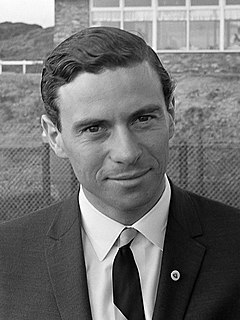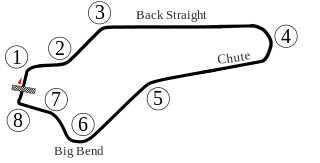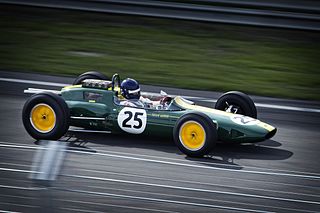
James Clark Jr. OBE was a British Formula One racing driver from Scotland, who won two World Championships, in 1963 and 1965. A versatile driver, he competed in sports cars, touring cars and in the Indianapolis 500, which he won in 1965. He was particularly associated with the Lotus marque.

The 1962 United States Grand Prix was a Formula One motor race held on October 7, 1962, at the Watkins Glen Grand Prix Race Course in Watkins Glen, New York. It was race 8 of 9 in both the 1962 World Championship of Drivers and the 1962 International Cup for Formula One Manufacturers. The 100-lap race was won by Lotus driver Jim Clark after starting from pole position. Graham Hill finished second for the BRM team and Cooper driver Bruce McLaren came in third.

The 1962 South African Grand Prix, formally titled the 9th International RAC Grand Prix of South Africa, was a Formula One motor race held at East London on 29 December 1962. It was the ninth and final race in both the 1962 World Championship of Drivers and the 1962 International Cup for Formula One Manufacturers. The 82-lap race was won by Graham Hill driving a BRM, the Englishman taking his first Drivers' Championship in the process, with New Zealander Bruce McLaren and local driver Tony Maggs second and third respectively in works Cooper-Climaxes.

The 1963 United States Grand Prix was a Formula One motor race held on October 6, 1963, at the Watkins Glen Grand Prix Race Course in Watkins Glen, New York. It was race 8 of 10 in both the 1963 World Championship of Drivers and the 1963 International Cup for Formula One Manufacturers. The 110-lap race was won by BRM driver Graham Hill after he started from pole position. His teammate Richie Ginther finished second and Lotus driver Jim Clark came in third.

The 1964 United States Grand Prix was a Formula One motor race held on October 4, 1964, at the Watkins Glen Grand Prix Race Course in Watkins Glen, New York. It was race 9 of 10 in both the 1964 World Championship of Drivers and the 1964 International Cup for Formula One Manufacturers. The 110-lap race was won by BRM driver Graham Hill after he started from fourth position. John Surtees finished second for the Ferrari team and Brabham driver Jo Siffert came in third.

The 1964 Mexican Grand Prix was a Formula One motor race held at the Ciudad Deportiva Magdalena Mixhuca in Mexico City on October 25, 1964. It was race 10 of 10 in both the 1964 World Championship of Drivers and the 1964 International Cup for Formula One Manufacturers.

The 1965 Italian Grand Prix was a Formula One motor race held at Monza on 12 September 1965. It was race 8 of 10 in both the 1965 World Championship of Drivers and the 1965 International Cup for Formula One Manufacturers. The race was won by Jackie Stewart who took his first Grand Prix victory, whilst driving for the BRM team. His teammate - Graham Hill - finished second after a closely contested race between both the pair and pole-sitter and Jim Clark, who driving for the Lotus-Climax team, had secured the 1965 Drivers' Championship at the previous race. His fuel-pump failure with a handful of laps to go, and also the preceding retirement of Ferrari driver John Surtees, ensured that Dan Gurney of the Brabham-Climax team picked up the final position on the podium.
The 1960 Formula One season was the 14th season of the FIA's Formula One motor racing. It featured the 11th FIA World Championship of Drivers, the third International Cup for F1 Manufacturers and numerous non-championship Formula One races. The World Championship commenced on 7 February and ended on 20 November after ten races. Jack Brabham won his second consecutive title with his Cooper team defending its constructors' title.
Michael Henderson Spence was a British racing driver from England. He participated in 37 Formula One World Championship Grands Prix, debuting on 8 September 1963. He achieved one podium, and scored a total of 27 championship points. He also participated in numerous non-Championship Formula One races, as well as sports car racing.

Richard James David "Dickie" Attwood is a British motor racing driver, from England. During his career he raced for the BRM, Lotus and Cooper Formula One teams. He competed in 17 World Championship Grands Prix, achieved one podium and scored a total of 11 championship points. He was also a successful sports car racing driver and won the 1970 24 Hours of Le Mans race, driving a Porsche 917, the first of Porsche's record 19 victories at the famous race.

Willy Mairesse was a Formula One and sports-car driver from Belgium. He participated in 13 World Championship Grands Prix, debuting on 19 June 1960. He achieved one podium and scored a total of seven championship points. He committed suicide in a hotel room in Ostend after a crash at the 1968 24 Hours of Le Mans forced an end to his career.
British Racing Partnership (BRP) was a racing team, and latterly constructor, from the United Kingdom. It was established by Alfred Moss and Ken Gregory – Stirling Moss's father and former manager, respectively – in 1957 to run cars for Stirling, when not under contract with other firms, along with other up-and-coming drivers.
Team Lotus was the motorsport sister company of English sports car manufacturer Lotus Cars. The team ran cars in many motorsport categories including Formula One, Formula Two, Formula Ford, Formula Junior, IndyCar, and sports car racing. More than ten years after its last race, Team Lotus remained one of the most successful racing teams of all time, winning seven Formula One Constructors' titles, six Drivers' Championships, and the Indianapolis 500 in the United States between 1962 and 1978. Under the direction of founder and chief designer Colin Chapman, Lotus was responsible for many innovative and experimental developments in critical motorsport, in both technical and commercial arenas.

The Lotus 25 was a racing car designed by Colin Chapman for the 1962 Formula One season. It was a revolutionary design, the first fully stressed monocoque chassis to appear in Formula One. In the hands of Jim Clark it took 14 World Championship Grand Prix wins and propelled him to his 1963 World Championship title. Its last World Championship win was at the 1965 French Grand Prix.

The Lotus 33 was a Formula One car designed by Colin Chapman and Len Terry and built by Team Lotus. A development of the successful Lotus 25, in the hands of Jim Clark it won 5 World Championship Grands Prix in 1965, assisting Clark to his second World Championship.

The Brabham BT19 is a Formula One racing car designed by Ron Tauranac for the British Brabham team. The BT19 competed in the 1966 and 1967 Formula One World Championships and was used by Australian driver Jack Brabham to win his third World Championship in 1966. The BT19, which Brabham referred to as his "Old Nail", was the first car bearing its driver's name to win a World Championship race.

The BRM P261, also known as the BRM P61 Mark II, is a Formula One motor racing car, designed and built by the British Racing Motors team in Bourne, Lincolnshire, England. The BRM P261 was introduced for the 1964 Formula One season, and its design was an evolution of Tony Rudd's one-off BRM P61 car of 1963. The P261 had a relatively long racing career; variants of the car were still being entered for Formula One World Championship Grands Prix as late as 1968. During the course of their front-line career BRM P261s won six World Championship races, in the hands of works drivers Graham Hill and Jackie Stewart, and finished second in both the Drivers' and Constructors' Championship standings in 1964 and 1965. Stewart, Hill and Richard Attwood also used works P261s to compete in the Tasman Series in 1966. The BRMs dominated, with Stewart winning four, Hill two, and Attwood one of the 1966 Tasman Series' eight races. Stewart also won the title. The works-backed Reg Parnell Racing team returned in 1967 with Stewart and Attwood, where Stewart added another two wins to his tally. In terms of races won and total Championship points scored, the P261 was the most successful car in BRM's history.

The Honda RA271 was Honda's second Formula One racing car, and its first to actually enter a race. The chief engineer on the project was Yoshio Nakamura, with Tadashi Kume in charge of engine development. It was driven in three races during 1964 by American driver Ronnie Bucknum.

The Brabham BT3 is a Formula One racing car. It was the first Formula One design to be produced by Motor Racing Developments for the Brabham Racing Organisation, and debuted at the 1962 German Grand Prix. The Brabham BT3 was the vehicle with which team owner – then two-time World Champion – Jack Brabham, became the first driver ever to score World Championship points in a car bearing his own name, at the 1962 United States Grand Prix. The following year Brabham also became the first driver ever to win a Formula One race at the wheel of an eponymous car, again driving the BT3, at the 1963 Solitude Grand Prix. The BT3 design was modified only slightly to form the Tasman Series-specification Brabham BT4 cars.

The BRM P57,, was a Formula One racing car built to race in Formula One from 1962 to 1965.
















